 Legacy Web page
Legacy Web pageLegacy web
page
 Legacy Web page
Legacy Web page
Click on picture above to go back to prior page
QuantumWorks AeroMech Division
d.b.a. QuantumWorks Aerospace Corporation (QAC)

This division is developing products to fulfill strong validated current market needs for both electric/hybrid vehicles and aerospace, both unmanned UAVs, (a.k.a. drones) and manned.
QWC has contributed to the Hybrid Electric Powertrain system developments at various companies, most notably, EVDrive Inc. (offices/labs in Portland, Oregon area). QWC staff headed up development of electric powersports products for MotoVox/APT where 2-wheel and generator products and the milestone AWD e-UTV engineering feasibility prototype were developed, which is discussed below. With QWC contribution and support EVDrive has built a number of electric and hybrid electric vehicles, one most notable is a powersports industry milestone in UTVs/side by side vehicles - a vehicle capable of high performance high and low speed torque vectoring and "zero-radius-turns" to get riders out of tight spots on and off the trail - see this video
QWC and it's partners are involved with development efforts that are in various stages of fund raising and engineering that include: most successful prototype and low-volume ELECTRIC and HYBRID ELECTRIC POWERTRAIN development and vehicle work done in the past at EVDrive (QWC co-founder was co-founder of EVDrive back ion 2011) - now QWC has new team members for its new projects.
Other work in ELECTRIC POWERTRAIN areas include: Modular Battery Systems for Electric Vehicles (sample designs developed by QWC for it's client); Range Extenders for Electric Vehicles, and the QWC Hybrid products, such as this supercar, a High Performance Hybrid Electric Exotic Sports Car and economy and performance enhancing add-ons for SUVs, RVs, Trucks and other vehicles. Hybrid Supercar Product engineering features overview located here and a product history & description located here.
In the manned aerospace vehicle world, the QAC-821 8 place helicopter concept we developed is discussed below. There are also 2 place scaled down versions of this helicopter design as well as UAV designs and new design for unique payloads for UAVs addressing strategic markets such as fire prevention and real-time terrain/structure/vegetation analysis.
QWC QAC division has many solutions for both manned and unmanned aircraft both all electric and hybrid powertrains - inquire via contact e-mail at bottom of this page.
The most notable Aerospace project, which can be discussed, is the QAC-821 World Class Flexible Utility Helicopter Concept Project.
This flexible well-thought out concept design has not yet to be funded to the point to create production level CAD for fabrication. Investors are being sought to fund the multi-phase program to take this project to 4 prototypes, testing and certification, ready for production in almost any country. The Phases are summarized below:
QAC also performs design, analysis and prototyping services for client projects as well. QAC's development partner, MPAS, facilities are located on Long Beach Airport, California. MPAS has 10,000 foot hanger space, 100 foot by 300 foot tarmac space and has performed many major structural re-design projects on existing helicopters, such as Eurocopter AS350, Bell Jet Rangers, Bell Huey/Cobras, and Hughes 500/OH-6s, which all have received full FAA certifications. MPAS has the following helicopters at its disposable for client projects: 2 AH1-T Cobras, 2 OH6-A Loaches, 1 UH1-K Huey and 1 UH1-B Huey and various mockups/props of many other aircraft, helicopters weapons and related systems. MPAS has performed many projects for the entertainment industry where detail and realism is paramount.
For listing of other research, design and development projects and services offered by the QAC team, please inquire via e-mail address at bottom of this page.
The QAC-821 project entails the development of a world class eight-place light-single turbine helicopter in 5,000 pound class category, based on proven state-of-the art technologies currently used by the World’s leading helicopter manufacturers.
This all-new model is designed to be specifically for international manufacturer through licensing, with the performance and specifications to make it quite competitive against existing models in its class category worldwide.
The vehicle will be FAA type certified and will be offered in three engine configurations; piston, single turbine and dual turbine. The project plan and team assembled will ensure both; that the “total lifecycle design” is cost-effective, low risk, and optimized for licensed manufacturer and that the vehicle meets and exceeds the end user’ requirements for truly performing more "work for the customer at lower overall cost".
The plan allows investors (with foreign interests) to participate in the technology transfer program of the projects' state-of-the-art design and manufacturing processes by providing their local industry with self-sufficiency in helicopter manufacturing.
QAC-821 Flexible Utility Helicopter Concept Development Project
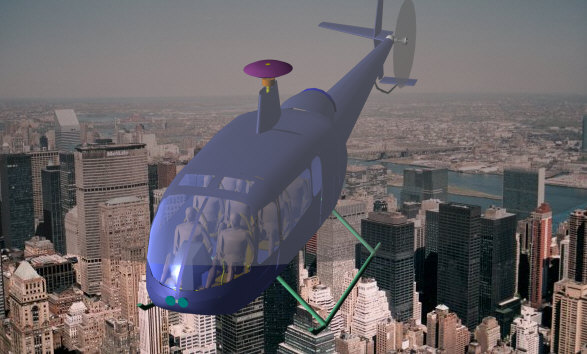
Market Needs
|
In 2001 commercial helicopter operators in Oil & Gas reported the largest amount of revenues (41% of the total reported) followed by Air Medical Services at 29% and tour operators at 7%. US operators estimated that revenues increased an enormous 41% between 1999 and 2001 and will continue at near that rate into the future. |
|
Commercial operators represent 63% of the total market. Corporate/Private operators represent 22% and Public Service 15%. |
|
Commercial operators operate 81% of the helicopters with Corporate/Private at 6% and Public Service at 13%. |
|
The average fleet size of Commercial helicopter operators was 10.2 helicopters, Corporate/Private 2.0 and Public Service was 7.0 |
|
Light-single turbine helicopters represent 49% of the total helicopters operated. |
|
Light-single turbines fly 57% of the total flight hours. |
|
Approximately 150 new turbine helicopters have been delivered to US operators in 2000. While the industry predictions for US helicopter operators look promising, they represent a fraction of worldwide demand for light long-range civil helicopter. |
|
Through 2005, Asia predicts a market capacity of 350 new turbine helicopters in Siberia, 300 in China and 250 in Indonesia and Malaysia. |
|
High import tariffs and high cost of licensed assembly of existing U.S. and European models prevent them from entering Asian and other world markets. |
|
Additionally, requirements for the design of this helicopter were developed/outlined during many meetings with Russian Mi-34 project engineers at Mil Company in Moscow and here in the states, helicopter operators based in St. Petersburg, and from essential feedback from other helicopter operators from around the world going through overhaul courses and pilots training at Robinson helicopter company in Torrance, California. |
QAC-821

Here is what many owner/operators worldwide really wanted their helicopters to be:
| Low initial purchase cost |
| Low while in operation required maintenance |
| High - time between overhauls |
| Low number of in-service repairs |
| Utilitarian Flexible design - perform more then one mission |
| High performance - agile |
| Safety - crashworthiness above all competitors |
| Low operating cost - fuel efficient |
| Ability to allow owner overhauls |
| Easy to maintain - accessibility |
| Parts interchangeability |
| All weather operation |
| Low noise - neighbor friendliness |
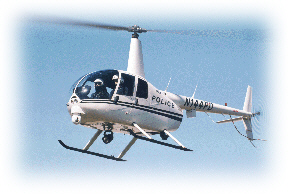
There is no doubt that Robinson R22 and R44 helicopters are the best things to happen in general aviation since the Piper Cub.
An experienced eye will notice that, even though R22 makes the best trainer money can buy, its assembly, maintenance and service techniques suggest a homebuilt kit machine. The fact that it has become so successful underlines Frank Robinson's excellent skills as a designer and entrepreneur. R44, on the other hand, is a far cry from R22. It is a product of quarter century of refinement and improvement upon R22s success and today remains the finest production helicopter for the masses. While having improved on everything from production methods to ease of operation and maintenance, R44, being a direct descendant of R22, retains many of R22s weak points. Ability to fly passengers only and not being able to perform any other tasks has been the major complaint from otherwise happy owners of this machine. Other quirks, like the capricious clutch actuator, fan-wheel and belt drive are simply tolerated because nothing in its price range comes even close to the performance it offers. During his employ at Robinson Helicopter Company, QAC's President and Chief Engineer noted the real needs of helicopter owners, operators, technicians and passengers and since leaving this employ has interviewed many of these people to help formulate with his new team and develop the cost-effective next step beyond these great current products.
The QAC-821 Utility Helicopter Project is the result of this work.
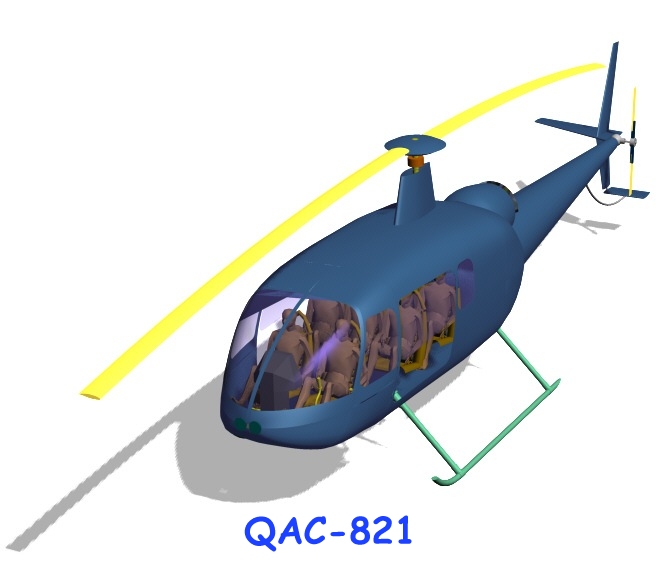
General Data Comparison
The first Four columns are for single turbine aircraft. The last column is just for comparison to one of the most successful helicopters produced today from Robinson Helicopters of Torrance, California. *QA-821 estimates are results of preliminary engineering and are intended for comparison purposes only
|
QAC-821 Single Turbine model |
Agusta A119 Koala |
Bell 407 |
AS350 B2 |
R44 Raven II |
|
| Empty Weight: | 2,540 lb* | 3,152 lb | 2,635 lb | 2,584 lb | 1,506 lb |
| Gross Weight: | 5,700 lb* | 5,997 lb | 5,000 lb | 4,960 lb | 2,500 lb |
| Useful Load: | 3,160 lb | 2,845 lb | 2,365 lb | 2,376 lb | 994 lb |
| Rotor Diameter: | 42 ft | 36.09 ft | 35 ft | 35.07 ft | 33 ft |
| No. of Blades: | 2 | 4 | 4 | 3 | 2 |
| Aircraft Length: | 48 ft.* | 42.68 ft | 41.8 ft | 35.86 ft | 38.25 ft |
| Fuel W/Reserve: | 1,200 lb* | 1,541 lbs | 983 lbs | 1,796 lbs | 294 lbs |
| Maximum Range: | 869 nm* | 552 nm | 380 nm | 679 nm | 556 nm |
| Maximum Endurance: | 8 hrs 40 min* | 5 hrs 42 min | 4 hrs | 4.5 hrs | 5 hrs 20 min |
| Disk Loading: | 4.11 lb/sq ft | 5.87 lb/sq ft | 5.2 lb/sq ft | 5.16 lb/sq ft | 2.92 lb/sq ft |
| Power Loading: | 8.03 lb/hp | 5.98 lb/hp | 6.15 lb/hp | 6.77 lb/hp | 8.33 lb/hp |
| Maximum Speed: | 155 kts | 152 kts | 140 kts | 155 kts | 130 kts |
| Cruise Speed 75% Pwr: | 133 kts | 140 kts | 133 kts | 133 kts | 117 kts |
| SFC: | .54 lb/hp/hr* | .59 lb/hp/hr | .58 lb/hp/hr | .58 lb/hp/hr | .43 lb/hp/hr |
| Avg. Fuel Burn: | 21 gph* | 40 gph | 38 gph | 35 gph | 17 gph |
| Rate of Climb: | 1,500 fpm | 1,850 fpm | 1,940 fpm | 1,675 fpm | 1000+ fpm |
| Hover Ceiling (I.G.E. @ GW): | 8,100 ft | 11,000 ft | 12,200 ft (ISA) | 9,850 ft | 8,950 ft |
| Hover Ceiling (O.G.E. @ GW): | 6,000 ft | 8,800 ft | 10,400 ft (ISA) | 7,550 ft | 4,500 ft |
| Engine / HP: | 1 x PWC PW207 @ 710 shp | 1 x P&W PT6B-37 @ 1,002 shp | 1 x Allison 250-C47B @ 813 shp | 1 x Turbomeca Arriel 1D1 @ 732 shp | 1 Lycoming IO-540 @ 300 hp (piston) |
| Seating / Arrangement: | 1 +7 / 2+3+3 | 1 +7 | 1 +6 | 1 +5/6 | 1 + 3 / 2+2 |
| Removable Seats: | Yes | Yes | Yes | Yes | No |
| Baggage: | 36 cu ft / up to 600 lbs. | 33.5 cu ft | 16 cu ft/ up to 250 lbs | 35.3 cu ft | 4 cu ft |
| Crashworthy: | Yes | Yes | Yes | Yes | No |
| Base Price: | U.S. $900,000 | $1.85 million + | $1.5 million | $1.3 million | $340,000 |
Design Considerations for QAC-821 Development
The following design issues and solutions are only a subset of the key design challenges which QAC and other designers face in configuring an aircraft targeted at the specific mission requirements discussed above.
A. Configuration
The logical approach to configure a helicopter is to locate
main rotor and drive train components above the cabin and to limit the shift in the center of gravity to a smallest
area below the main rotor mast in order to have smallest moment of inertia for the whole ship - optimizing the
effects of tail rotor and cyclic control inputs. This approach presents five problems:
1. Center of gravity shift. Since the drive train is compacted around the main rotor, fuel must be stored behind
cabin, hence the center of gravity shifts constantly in flight as fuel is consumed.
2. Clean aerodynamics. Placing the drive train above cabin provides good cooling but also increases the cross-sectional
area, produces higher drag and requires more power at cruise.
3. Positive fuel pressure. Locating engine above fuel cells makes the performance of fuel pumps critical, requiring
a complex network of boost and backup sources of fuel pressure.
4. Service, maintenance, preflight and periodic inspections are further complicated by an overhead placement of
drive train.
5. Crashworthiness. Large percentage of crashes can be made survivable by preventing the drive train and main rotor
from crashing on top of the human cargo.
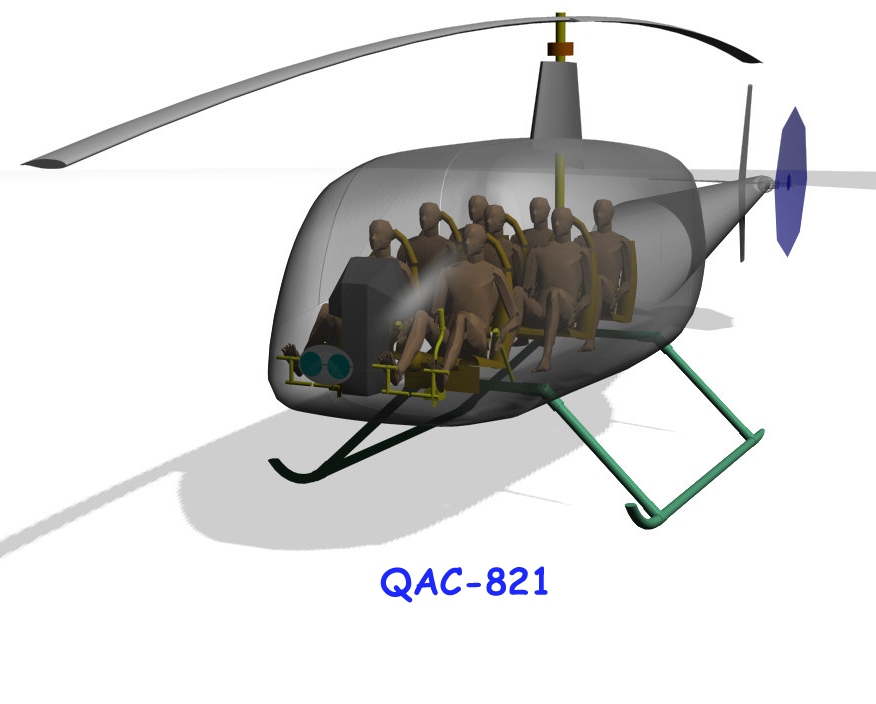
B. Noise level and safety
A large area tail-mounted rotor is the most effective means
of yaw control for helicopters.
There are four problems associated with the presence of tail-mounted rotor:
1. Noise. The interaction of main and tail rotor's tip vortices is a major source of noise, more then twice of
the engine's noise level.
2. Vibration. The centrifugal force on a tail rotor is much higher then on the main, hence, tail rotor and it's
drive shaft are extremely sensitive to imbalance conditions, requiring constant re-balancing and maintenance.
3. Safety. Tail rotor strike is attributed to nearly half of all helicopter accidents, in the air and on the ground
- a tree branch, a bird, a pebble, even a disoriented person on the ground can come in contact with the rotating
tail rotor, resulting in the destruction of a machine with often fatal outcome.
4. Mechanical complexity. Because in flight the tail rotor experiences the same dissymmetry of lift as the main
rotor, it's hub components must be as complex as those found on the main rotor, with the exception of cyclic controls.
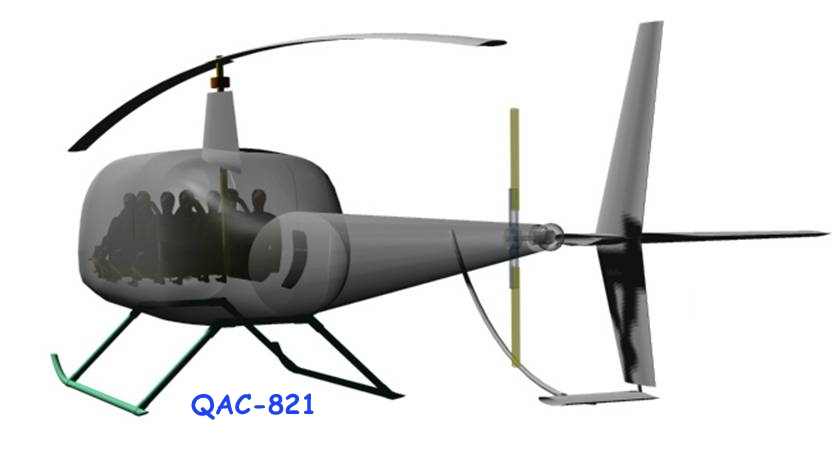
C. Efficiency
re: Non-turbine version of QA-821 and a Potential "Experimental
Designation Kit" product - Recent improvements in the reliability and affordability of helicopter turboshaft
powerplants hold much promise for general aviation applications but the fact remains - reciprocating powerplants
offer 40% lower fuel consumption and 50% lower cost of overhaul.
There are three problems associated with the use of piston engines
in a helicopter:
1. Lack of a helicopter piston engine. To this day designers of all type certificated production helicopters have
been forced to utilize engines originally designed to power airplanes.
2. Engine cooling. Airplane piston engines are configured for tractor installation making use of propeller slipstream
for cooling. Helicopters do not enjoy this option and must provide elaborate schemes to cool their rear-mounted
engines in hover and in cruise adding to complexity, weight, vibration and fatigue.
3. Low power-to-weight ratio. At present the best power-to-weight ratio offered by certified aircraft piston engines
is 1/2 - two pounds of engine mass for every delivered horsepower.
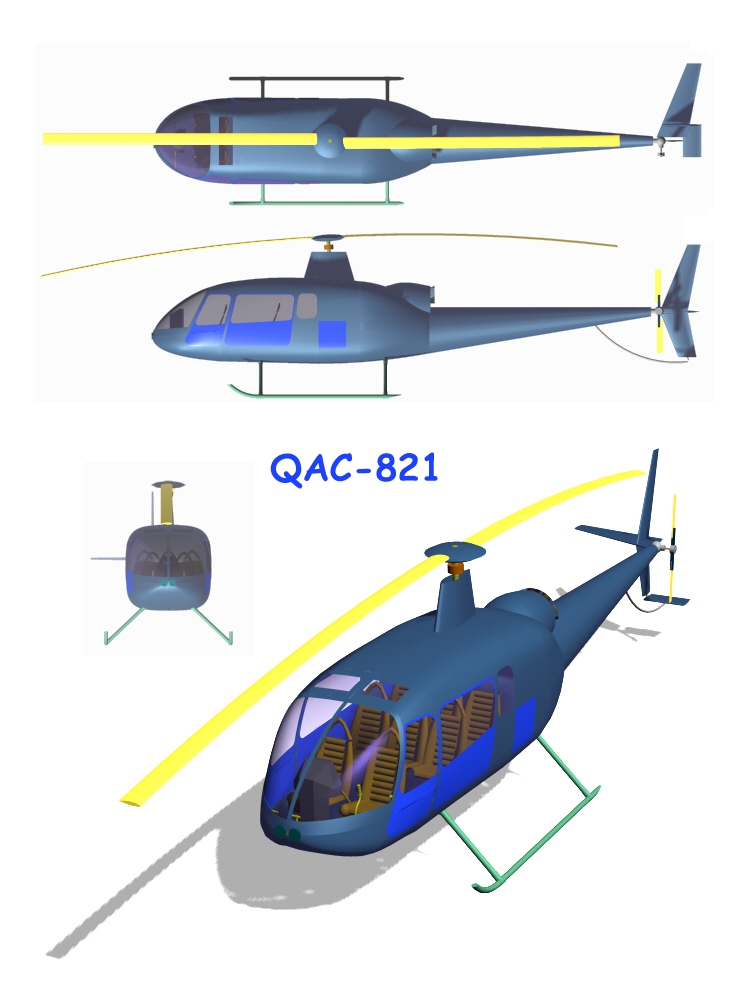
Solutions
A. QAC-821 Phase I Development
The QAC team will construct an experimental helicopter prototype with
the following configuration:
1. Main rotor, six-foot tall gearbox (MRGB) is to be centrally located on an airframe at shoulder height. Eight-seat
cabin located forward of MRGB. Fuel tanks to be located on either side of MRGB at center of gravity.
2. Engine, hydraulic & overrunning clutches, reduction gearbox, MRGB & fan-in-tail drive shafts are to
be located aft and below MRGB & fuel tanks.
3. Fuel tanks, to be located above the engine, provide constant positive fuel pressure to the two of engine's fuel
pumps.
4. Gearboxes, engine and other critical components are to be located for easy preflight inspection, service and
maintenance.
5. MRGB, engine & drive train are to be located in a favorable crashworthy position.

B. Improvements
QAC-821 follow-on development option - Fan-In-Duct anti-torque
and yaw control unit is to be installed to reduce noise and increase safety.
1. Variable pitch Fan-In-Duct (FID) unit is to be located aft of reduction gearbox and ambient air is taken in
forward of the unit through peripheral screen. Direction and mass of ejected air at the end of the tail boom is
controlled by pilot's foot pedals.
2. FID is to be driven by the shaft which is attached via flex-plates to the first stage of reduction gearbox rotating
at engine speed. It is to be permanently coupled by the intermediate and output gears to MRGB drive shaft, attached
to reduction gearbox and MRGB via flex-plates.
3. Safety will be increased due to prevention of foreign objects coming in contact with FID unit by the installed
inlet screen/particle separator.
4. Since the FID will not encounter the dissymmetry of lift it will not need the teetering hinge. This will reduce
pitch link bearing motion and parts count, increasing component life and reliability.
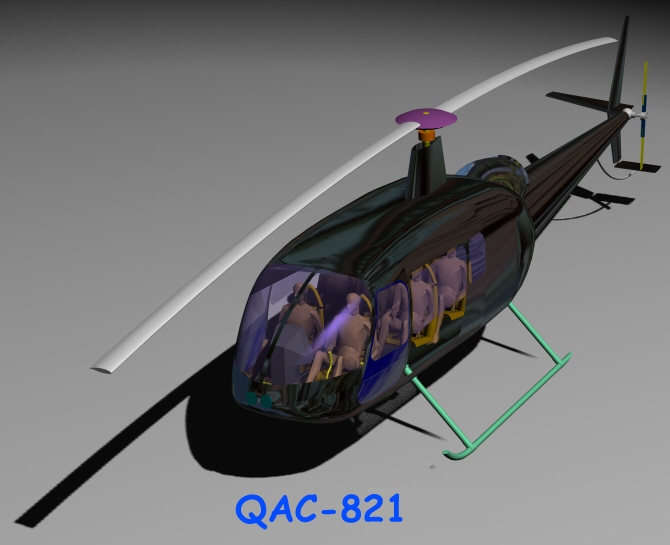
C. Efficiency
The
piston version of the production prototype of this helicopter is intended to be powered by a six-hundred horsepower
turbocharged liquid-cooled certified aviation vee-eight automotive derivative engine. This engine offers an average
fuel consumption of 24 gallons per hour - less then half of equally rated turboshaft powerplants.
1. Canadian aircraft engine manufacturer has been awarded certification on it's new line of aviation piston engines
in early 1998. Same manufacturer has agreed to certify a simplified (less gearbox & governor) version of it's
liquid-cooled engine for helicopter application.
2. Liquid cooling eliminates the need for bulky fans and the vibration & fatigue associated with them. It makes
engine placement more flexible while requiring less space.
3. Elimination of cylinder baffling opens more space for access and ease of maintenance.
4. Power-to weight ratio is nearly doubled when compared to an air-cooled engine.
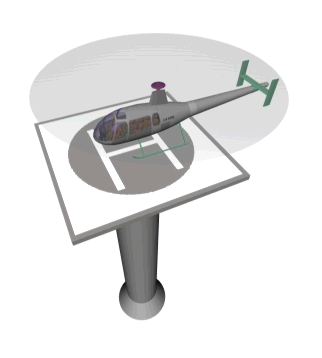
Design "k159h", a QAC Favorite for Drone/UAV Development with Distinct Advantages over BOTH Multi-Rotor Drones and Helos like Yamaha RMAX
Suggested powertrain: electric motor per rotor with Series PHEV version of EVDrive-Train, similar to what was used in EVDrive powertrain for Volta Volare
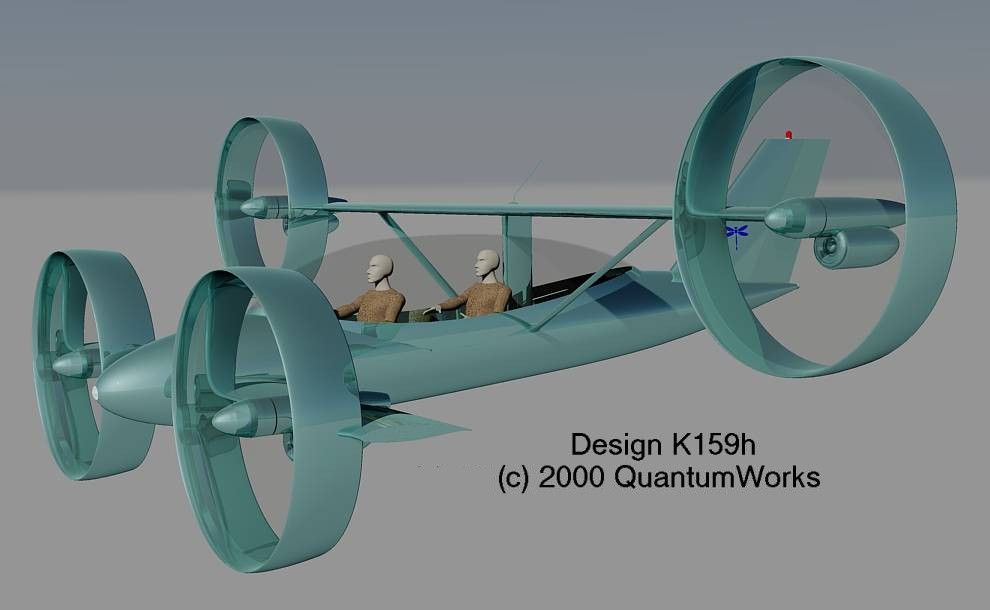
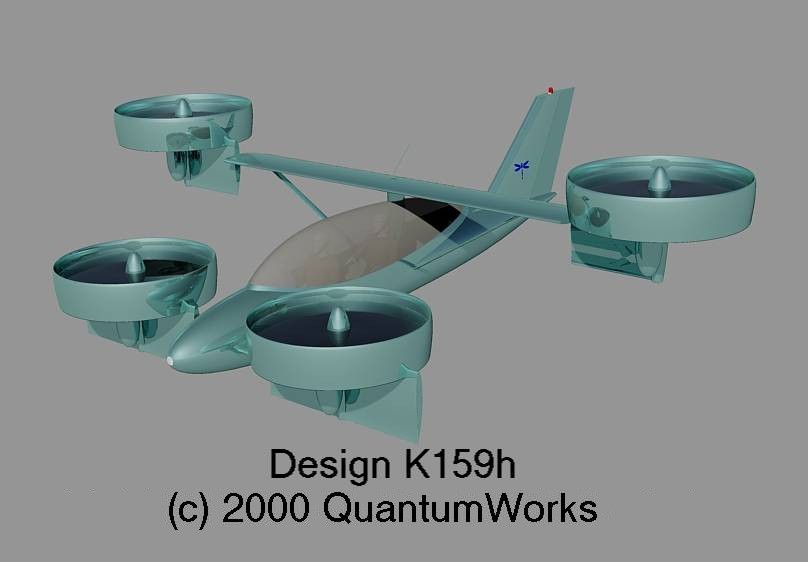
Team and Management
This projects’ initial design and development Phases are being conducted under auspices of the QuantumWorks Corporation, an entrepreneurial technology, engineering and new product/businesses development company operating as a California C corporation for over 9 years. Specifically this project is being developed within the QuantumWorks "Aero Division" or d.b.a. QuantumWorks Aerospace Corporation or "QAC" for short, under the leadership of a core team managing the key group of industry leading consultants on this project. The core team consists of: Steve E. Tice, the CEO of QuantumWorks (40 years in Engineering, Design and Digital Products development, recent years in spinning off projects to new companies like Poseidon AmphibWorks, etc., Business Strategy & Funding Acquisition mentoring, MS/BS Aeronautical Engineering, Minors in Computer Graphics and Management, Rensselaer Polytechnic Institute), M.K, the President and Chief Engineer of QAC (15 years in Aerospace products engineering and servicing, BS Aeronautical Engineering / Aircraft Maintenance Engineering Technology, Northrop Institute of Technology, FAA IA), Dr. A.M, the CFO / SVP Analysis of QAC, Mr. EA, a FAA DER, and Mr. MC, a FAA DAR, and QAC's development partner, MPAS, facilities are located on Long Beach Airport, California. MPAS has 10,000 foot hanger space, 100 foot by 300 foot tarmac space and has performed many major structural re-design projects on existing helicopters, such as Eurocopter AS350, Bell Jet Rangers, Bell Huey/Cobras, and Hughes 500/OH-6s, which all have received full FAA certifications. MPAS has the following helicopters at its disposable for client projects: 2 AH1-T Cobras, 2 OH6-A Loaches, 1 UH1-K Huey and 1 UH1-B Huey and various mockups of many other aircraft, helicopters and weapon props. MPAS has performed many projects for the entertainment industry where detail and realism is paramount. See more of QAC design concepts for BOTH unmanned drones/uavs and manned aircraft.
QAC has assembled a team of industry leading engineers and manufacturing specialists, including FAA inspection talent, from the World’s leading helicopter and aerospace manufacturers to insure that this project successfully meets its goals. The development team for this project has the proven track records in managing large budget complex and risky engineering efforts and insuring that products/milestones get accomplished on time and within budget with constant and active risk mitigation throughout the projects' lifecycle.
QWC and its team members have also been engaged in state-of-the-art engineering efforts focused at development of new Consumer multi-media product designs, Spacecraft, Space Station & Space colonization for innovation and economic benefit (Protean Space Station Construction System- Ollie P. Harwood, SpaceHAB, The America 500 Space Initiative - Ted (Austin) Ostindien, S.E.Tice, Aircraft designs (QAC-821 world class utility helicopter) and high performance energy efficient, low emissions hybrid electric vehicles.QWC and it's partners are involved with development efforts that are in various stages of fund raising and engineering that include: QAC-821 helo mentioned above and the L3R_QWC "Hybrid supercar", a High Performance Hybrid Electric Exotic Sports Car. Product engineering features overview located here and a product history & description tear sheet located here.
This team is used their engineering prototype testbed to stage a cross the country on a tank on a gas Freedom drive "protest" to show what can be done today by today's automobile manufacturers. Sponsor flyer on this event located here.
For new projects, investment and any other additional information, feel free to e-mail: info "at" quantumworks.com
© 1999-2023, QuantumWorks Corporation
All Rights Reserved